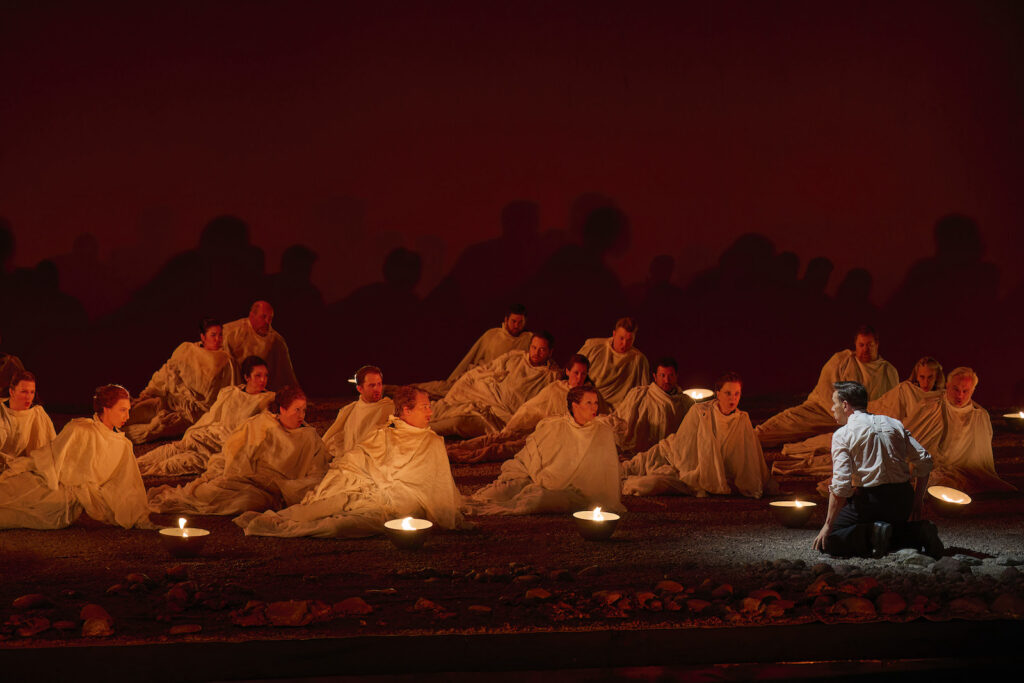Writing in 1919 in an essay entitled, Instinct and the Unconscious, Swiss psychiatrist Carl Jung first proposed his notion of archetype as emblem. Thirty years later, American folklorist/philosopher, Joseph Campbell published his seminal study, The Hero with a Thousand Faces, in which he proposed his principle of monomyth. Taken together, the two premises essentially survey much the same psychic terrain, the prolific sweep of ancient storytelling yielding broad insight into the human condition. Primal, poetic, richly metaphoric, mirrored sagas of disaster and daring, tragedy and triumph shared across countless cultures provide a ready context for Jung and Campbell both to explore the human impulse to prevail.
Recurringly familiar narrative motifs, first principles of The Hero’s Journey — Departure, Initiation, Return — achieve a level of thematic prominence here common to a wide variety of mythic narratives, Mozart’s The Magic Flute, Beethoven’s Fidelio and Wagner’s Das Rheingold included. “Once upon a time” becomes all time in all heroic settings everywhere. Raven steals fire from the Eagle Guardian of the Sun and Moon. The goddess Isis searches the length and depth of the Nile to reclaim her husband’s body, magically reassembling Osiris’ scattered remains. A divinely favoured Thracian musician travels to the underworld in desperate search of his beloved dead wife.
Likely derived from the Greek lyric poet, Ibycus, in the 6th century BCE, the Orpheus myth endlessly enthralls, its message of deathless love and devotion ringing down through the ages. Popular stage works like the recently toured Broadway musical, Hadestown (2023), and Marcel Camus’ older screen adaptation, Black Orpheus (1959), continue to hold what has long been an excruciatingly personalized portrait of human aspiration in the foreground of our collective imagination.
Radiating its own brand of wonder, director Robert Carsen’s ground-breaking Orfeo ed Euridice, premiered in May 2011, currently enjoying a welcome revival on the Canadian Opera Company’s Four Seasons Centre stage, commands whole-hearted attention, composer Christoph Willibald Gluck’s operatic classic — its three act structure reminiscent of The Hero’s Journey — given dazzling theatrical equivalency.
Essentially stepping out of the established mid-18th century mainstream, Gluck fashioned a vibrant, essentially timeless score of immense refinement, intensely expressive, unembellished virtually to the point of minimalism by Baroque standards. Partnering with fellow artistic dissenter, librettist Ranieri de’ Calzabigi, the discerning composer resolved to rid opera seria of its reliance on tangled, over-elaborated music and drama in favour of a focused “noble simplicity”. Excessively inflated, gaudily ornamented arias were banished, replaced by long ribbons of recitative, fully accompanied, melody and harmony made to serve the express interests of narrative, solos emerging organically from the mix.
Conducting a superb Baroque-friendly ensemble drawn from the ranks of the ever adaptable Canadian Opera Company Orchestra, acclaimed Quebec City-based early music specialist Bernard Labadie leads with great sensitivity and flair in a brilliant, markedly empathic performance of Gluck’s extraordinary reformist settings.
Cued by story, framed by music in true Gluckian fashion, revival director Christophe Gayral meticulously reconstructs Carsen’s stark scenic aesthetic, no less compelling after fourteen years. Set is little more than a broad, steeply raked platform dusted with barren soil bounded by a random scattering of river rock perhaps referencing the Styx. Principal action is frenzied; tableaux tautly depicted; principals coolly spotlit; chorus silhouetted against a horizonless cyc. Stagecraft is basic, characterized by simple, elemental displays of theatrical sleight of hand. An eerie conglomeration of ominous boulders comes alive, startled sleeping Furies emerging from cocoon-like shrouds to chilling effect. Bowls of flickering flames illuminate the underworld. Costuming is contemporary noir.
Ballet, although conspicuously present musically on at least two occasions in Orfeo ed Euridice, is not specifically referenced here, a sombre procession of black-suited guardians at the Gates of Hades; a solemn parade of symbolic wounded heroes in the Elysian Fields do, however, convey something of Gluck’s intention to pay homage, albeit vaguely, to his fraught azione teatrale’s French antecedents. In fact, although first presented in Italian in Vienna in 1762 — the version showcased by Carsen and company currently on offer at the FSC — an all-French language treatment helmed by Gluck ultimately surfaced in Paris twelve years later, somewhat unorthodox happy ending still stubbornly in tact, at the urging of no less a fellow stylistic rebel than Marie Antoinette who had, quite possibly, studied music with the composer as a girl in the Habsburg capital.
Appearing as Orfeo, British countertenor Iestyn Davies effectively embodies the anxious hero, physically restive, vocally assured. Tessitura, perhaps not quite as high as Gluck’s stratospheric tunings for the Paris stage is, nevertheless, demanding in the extreme when applied to the role. Originally written for alto castrato, Orfeo, an active force in the proceedings from curtain rise to close, demands a tireless measure of technical precision and flawless technique. Davies’ thrilling La speme in sen ritorna (“Hope is reborn in my soul”) ends Act I on ringing notes of exultation, his gorgeous, impassioned handling of Gluck’s great iconic standard, Che farò senza Euridice (“What shall I do without Euridice”), highly deserving of any amount of enthusiastic applause.
Singing Euridice, soprano Anna-Sophie Neher gifts the evening with a performance of unconstrained emotion, her voice ringing with bewilderment and hurt. Forceful, sparkling, blessed with high-flying top notes, Neher soars, her finest moments of expression movingly embodied in Act III duets with Davies. Qual vita è questa mai (“What life is this now?”) laments her Euridice, spiralling deeper and deeper into despair, convinced Orfeo’s love has fled. Neher strikes straight to the heart — poignant, irrepressible, boundlessly human.
Fellow soprano Catherine St-Arnaud is Amore, Jove’s impish messenger, an all-important trouser role in this decidedly affecting Orfeo ed Euridice and, in Carsen’s handling of events, something of a genial master of ceremonies. Breezing through a variety of deus ex machina assignments with a mischievous, playful air, St-Arnaud twinkles and charms. A delightfully gifted singer actor of great vivacity and wit.
The Canadian Opera Chorus, two dozen plus choristers strong, hugely amplify any number of electrifying scenes, arguably nowhere more thrilling than in Orfeo’s aforementioned encounter with the awakened Furies. Chi mai dell’Erebo/Fra le caligini/Sull’orme d’Ercole E di Piritoo/Conduce il piè? (“Who is this who draws near to us/through the gloom of Erebus/in the footsteps of Hercules/and of Pirithous?”)
Wonderful. Tutto.


